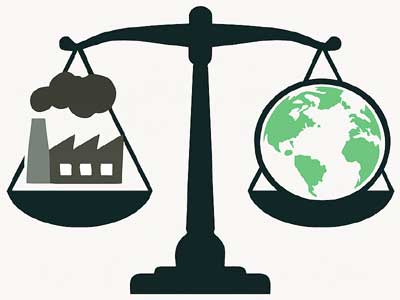On 18 November, in a quiet yet bold turn, the Supreme Court reopened a door it had once slammed shut. What was earlier declared illegal has now been allowed as an exception. The shift is not merely in interpretation; it marks a redefinition of accountability itself.
In a country where the air is poisonous, rivers are terminally ill, and forests are shrinking into memory, this verdict is not just a legal curiosity. It feels like a warning. Read in Hindi: “हमसे ग़लती हो गई है अनजाने में, जुर्माना ले लो...”
Three decades ago, back in 1993, Justice Kuldeep Singh’s historic judgment had imposed an uncompromising ban on polluting industries in the Taj Trapezium Zone. Foundries closed, glass factories shut down, and thousands of workers were rendered jobless. Agra’s economy took a severe blow. Yet the message was unmistakable: when the environment is at stake, profit must step back.
But that moral clarity has steadily blurred. Over the years, judicial pronouncements on environmental protection have grown tangled, hesitant, and at times, contradictory.
Only months ago, environmentalists celebrated the Vanshakti judgment, which declared that granting approvals retroactively violated both the Constitution and environmental law. But in Credai vs Vanshakti (Review, 2025), the court reversed its own stance—this time invoking ‘public interest’. The new principle appears to be: if the violation was ‘unintentional’ or the work ‘permissible’, the project may still survive.
But how does a river distinguish between ‘accidental’ and ‘deliberate’ pollution? How does poisoned air calculate intent?
The court’s faith in ‘heavy penalties’ and ‘restoration orders’ also borders on naïveté. Penalties in India are rarely collected, restoration rarely happens, and once a massive construction or industrial unit begins operations, shutting it down becomes practically impossible. The ruling risks sending a dangerous message: build first, seek forgiveness later.
This is not an isolated judicial wobble; it is becoming a pattern. In the 2024 Great Indian Bustard case, the court eloquently affirmed climate rights, but in the same breath allowed overhead power lines that threaten the very species it sought to protect.
Governments, pressured by corporate lobbies and impatient industrialists, increasingly view environmental regulations not as duties but as inconveniences. Every year, exemptions expand; every year, accountability shrinks.
Amid all this, Justice Ujjal Bhuyan’s dissent glows like a rare beacon. He warned unequivocally that retroactive clearance undermines the architecture of environmental governance. Yet the broader system now seems more concerned with safeguarding airports, housing projects, and power plants than with safeguarding rivers, forests, or public health.
And that raises a fundamental question: if hospitals, malls, airports, and factories can be built without permission and later regularised, then what meaning remains in the law?
India’s environmental catastrophe is not theoretical. Delhi-NCR chokes every winter. The Yamuna, Hindon, and Sabarmati are biologically dead. Forest cover is thinning. Climate disasters—from cloudbursts to heatwaves—are accelerating. At such a moment, the environment ministry’s retreat is not just a technical lapse; it approaches a moral failure.
When the law becomes flexible, it becomes fragile. What begins as an ‘exception’ quietly becomes a tradition. Mining lobbies once received narrow exemptions; soon, exemptions became routine. Now, ‘violate first, regularise later’ has evolved into a legitimate political strategy.
This legal flexibility does not strengthen governance—it recruits lawbreakers. Prevention, once the foundation of environmental law, is being replaced by a new logic: cause damage first, pay later. And when a violator can buy cleanliness with money, what deterrence remains?
This verdict may well be remembered as a turning point. In attempting to find balance, the system has tilted toward the powerful, leaving the environment—and ordinary citizens who breathe the consequences—to pay the price.
Environmental activists interpret the new precedent starkly: complete a project without clearance, claim it was an ‘honest mistake’, argue it serves ‘public interest’, pay a hefty fine, and the court may open the gates of ex-post facto approval. The formula is simple: break the law, build big, pay a price, walk free.
India’s history with penalties and restoration does not inspire confidence. From the ravaged Aravallis to the ravaged mines of Goa, fines are paid, legal status is granted, but the land remains scarred. The damage is seldom reversed; the violator seldom deterred.
Even in the Great Indian Bustard case, the order mandating the burial of overhead wires was diluted with simultaneous exemptions—another illustration of how exceptions quietly swallow the rule.
Thus, the true question remains: when the nation’s air is toxic, rivers are dead, and forests are fast receding, can a ‘damage first, pay later’ model ever qualify as environmental justice?
The court has opened the door again. What remains to be seen is: how wide this door swings—and who all walk through it.

















Related Items
Financial concerns affect electricity usage more than environmental…
Growth and environmental challenges for Indian industries
Environmental crisis signals urgent need for action